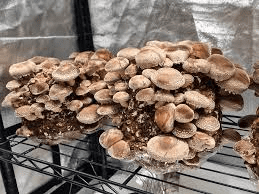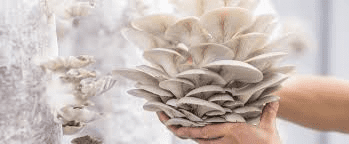A mushroom (Agaricus bisporus) is a fleshly fungi, spore-bearing fruiting bodies of typically produced above ground on soil or on their food sources fruiting body of fungi.
Its botanical name is Agaricus bisporus (Basidiomyota, Agaricomycetes) that have a stem called (a stipe), a cap called (a pileus), and gills each called (a lamella) on the underside of the cap just as do store-bought white mushrooms.
However, mushrooms can also be a wide variety of gilled fungi, with or without stems and the term is used even more generally to describe both fleshly fruitbodies of some Ascomycota and woody or leathery fruit bodies of some Basidiomycota, depending upon the context of the usage.
Usually forms deviating from the standard form have more specific names, such as puffballs, stinkhorn , morels etc and gilled mushrooms themselves are often called agarics in reference to their similarity to Agaricus or placement in the order Agaricales.
By extension, mushroom can also designate the entire fungus when in culture or when referring to the whole thallus (called a mycelium) of species forming fruit bodies called mushrooms.
Types of Mushrooms

There are several types of mushrooms. However; it is found that there are those that are edible and non-edible ones.
Our minds will now zero down to the edible ones which include:-
a) Button
b) Oyster
c) Shiitake
d) Straw
e) Chinese mushroom
f) Termitomyces
Benefits from Mushrooms
A) Nutritional Values of Mushroom
(i) Protein: Protein content of dry weight is between 19% and 35%
(ii) Fat: Low rate of fat content between 1-8%
The high content of linollic acids is one of the reasons why mushrooms are considered healthy food.
(iii) Vitamins and minerals: Mushrooms are a good source of vitamins such as thiamine (Vitamin
(iv) Mushrooms also contain riboflavin (vitamin B2), miacine, bio tine and ascorbic acid (vitamin C), folic acid. They also contain significant amounts of phosphorus, sodium, potassium, calcium, magnesium, iron and Zinc.
Read Also: Health Benefits of Beans and Why you Should Eat Beans
(B) Medicinal Values of Mushroom
(i) Heart and coronary diseases: Lower fungi have yielded important medicines like penicillin and other antibiotics from penicillium (a common contaminant in mushroom cultivation). Mushrooms contain substances which lower the cholesterol level in serum and liver which makes it good for those suffering from heart diseases.
(ii) Cancer: Many mushrooms contain substances, which suppress the growth rate of tumours.
(iii) Diabetes: Research in animals indicates that mushrooms like pleorotus ostreatus (Oyster), cord caps, saneness, lentinula edodes and grifola frondosa have a positive effect on diabetes.
(iv) Protection against free radicals and infection: Free radicals can damage body cells and induce cancers. Free radicals are the result of specific transformation process. Many bio active compounds protect the body against these radicals.
These substances are often called anti oxidants and are present in many mushrooms. In other words, the body immunity is boosted. This will be a relief to those suffering from HIV/AIDS.
Nutrient Power of Mushroom

They contain all nine essential amino acids unlike other plants
Calcium
Iron
Phosphorus
Potassium
Vitamins: B 1, B2, B3, B12, C, D.
- Good source of fibre, Folic acid and Low in Fats hence diabetic, and fat infested people too can enjoy it.
- Low in sodium.
- Good for fighting all diseases and conditions associated with ageing.
Read Also: Health Benefits of Fruits and Vegetables
Mushroom consumption is good for people with:
– Diabetes
– Blood pressure
– HIV
– Cancer
– Hepatitis
– Gout
The following are the terms we shall use most in our study trek
- Substrate: Compost in which to grow the mushrooms i.e sugarcane bagasse and leaves, banana fibre and leaves, cotton waste etc.
- Mycelium: Vegetative part of fungi. These are thin spider web-like growths that bear spores and grow through carrier materials or substrate.
- Spawn (mushroom seed): These are mycelium growing through carrier materials or substrate normally wheat or sorghum grains. Or mushroom seeds
- Inoculation: Introduction of mycelium to carrier or spawn to substrate under extreme hygienic conditions.
- Spawn Run: Describing initial appearance of mycelium in substrate.
- Primordium or Pin heads: The first visible mushrooms in the beginning of growth.
- Cluster: Several mushrooms growing together from one point or from one stem.
- Fruiting: Mushrooms are said to be fruiting when the pin heads start to appear.
- Fruit body: This is the actual mushroom
- Run through (Colonization): In this the substrate is grown with mycelium.
- Contamination: The presence of unwanted organisms like green, black and pink moulds, bacteria/viruses and weed (competitor) mushrooms in the substrate.
- Culture: Nutrient materials used for mycelium growth in laboratory.
They include growth in organic soils, plant growth regulators, Vitamins, amino acids and complex organic supplements, carbohydrates, water among others
Requirements for Mycelium Growth and Fruit Body Formation for Oyster Mushroom include the following;
-Temperatures of 15-32oC
-Ph of ABOUT 6.5
-Carbon dioxide (CO2) level to be between15-20%
- Humidity to be between 86-90%
-Reduce CO2 to between 0-0.6percent
-Regulate the temperatures to 10-28o C and humidity levels of 86%. If the mushroom develop long stalks and short cap your lighting and ventilation will have been inadequate.
Read Also: The Different Parts of the Plant -Crop Forms
Inputs for Mushroom – Polythene bags (black or white)
- Lockable metal Drum
- Polythene tubes
- Methylated spirit or jik
- Table or polythene sheet (3 metres)
-Table spoon - Fuel
- Water
- Labour
- Spawn (seed)
- Weighing scale
- Lime
- Supplement (Soybean meal or keratin)
- Molasses
- Substrate
- Sisal twine
- Soap
- Shed
- Basin
- Hand gloves
- Dust coat
- Cap
- Dust masks
- Hand spray pump
Read Also: Feed and Nutrition Management for Cattle
Frequently Asked Questions
We will update this section soon.


Great information. I need to continue learning more and more. Thanks a lot.
That’s great to hear, and we are glad that you find our article very helpful.